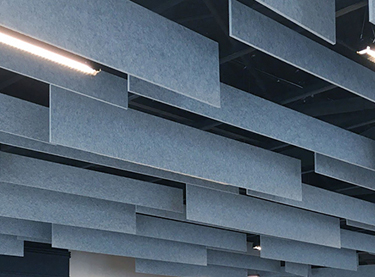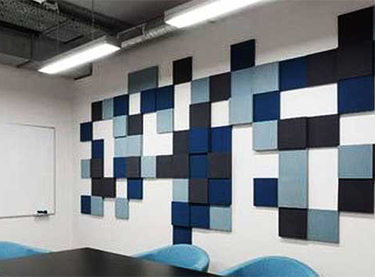Classification of sound-absorbing panel structure.
2021-09-09
The sound-absorbing wedge is a special sound-absorbing structural material used for strong sound absorption field. It is shaped and cut from porous (or fibrous) materials to make a cone-shaped or wedge-shaped sound absorbing body, which is firm and does not deform. The sound-absorbing wedge is suitable for strong airflow environment. The main object is a high-quality anechoic chamber. It absorbs low frequencies more effectively, can eliminate standing waves and meet the requirements of eliminating echo. The low cut-off frequency sound absorption coefficient is greater than 0.99. Compared with ordinary sound-absorbing wedge, the V-shaped and W-shaped sound-absorbing wedge made of polyester have the characteristics of small size and more reasonable price.
② Diffuser
In addition to having all the functions of a flat sound-absorbing panel, the diffuser sound-absorbing panel can also conduct sound waves at different angles through its three-dimensional surface, eliminating the blind spots in the diffusion process of sound waves, improving sound quality, balancing the sound, thinning the accent, and weakening the treble , Compensate for bass.
Three-dimensional triangular or cylindrical grooves on the front of the MDF, sound-absorbing materials with circular holes on the back, spray paint on the finish (color can be selected according to customer requirements), and fire-resistant sound-absorbing cloth on the back.
③Aluminum honeycomb perforation
The structure of the aluminum honeycomb perforated sound-absorbing panel is a perforated panel and a perforated back panel. The aluminum honeycomb core is directly bonded to form an aluminum honeycomb sandwich structure with high-quality adhesives. A layer of sound-absorbing cloth is pasted between the honeycomb core, the panel and the back panel. Since the honeycomb core in the honeycomb aluminum plate is divided into numerous closed cells, the air flow is prevented, the sound wave is obstructed, and the sound absorption coefficient (up to 0.9) is improved. At the same time, the strength of the plate itself is improved, so that the size of the single plate can be Achieve greater, and further increase the degree of design freedom. According to the design of room acoustics, different perforation rates can be designed, and the sound absorption coefficient of the combined structure can be controlled within a certain range, which not only achieves the design effect, but also can reasonably control the cost. By controlling the perforation aperture and distance, the perforation rate can be changed according to the customer's requirements. The maximum perforation rate is less than 30%. The aperture is generally selected as ∮2.0, ∮2.5, ∮3.0 and other specifications. The backplane perforation requirements are the same as the front panel, and the sound-absorbing cloth is used. High-quality non-woven fabrics and other sound-absorbing materials.
④Wooden perforation
The perforated gypsum board has cylindrical holes penetrating through the front and back of the gypsum board, and the back of the gypsum board is formed by pasting a breathable backing material and a sound-absorbing material that can absorb incident sound energy. The sound absorption mechanism is that there are a large number of tiny interconnected pores inside the material. Acoustic waves can penetrate into the material along these pores and generate friction with the material to convert sound energy into heat energy. The sound absorption characteristics of porous sound-absorbing materials are that the sound absorption coefficient gradually increases as the frequency increases, which means that low-frequency absorption is not as good as high-frequency absorption.
























































